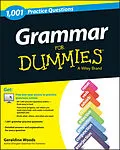Practice makes perfect - and helps deepen your understanding
of English grammar
Establishing good grammar habits will set you up for success.
From English class to writing your college essay, from
corporatecommunications, to updating your social media sites,
good grammar is essential and now you have 1,001 ways to deepen
your understanding and practice your skills.
1,001 Grammar Practice Problems For Dummies takes you
beyond the instruction offered in a typical English grammar course
and offers a hands-on understanding of grammar and its principles.
* Gives you a chance to practice and reinforce the skills you
learn in a typical English grammar course
* Helps you refine your understanding of English grammar
* Practice problems range in difficulty and include detailed
explanations and walk-throughs
Whether you're studying grammar at the high school level or
just brushing up on your grammar skills, 1,001 Grammar Practice
Questions For Dummies offers an on-the-go opportunity to
succeed.
Autorentext
Geraldine Woods teaches English and directs an
independent study program for gifted students at the high school
level. She has more than 25 years of teaching experience and has
helped students prepare for the SAT for more than 30 years. She has
written more than 50 books, including English Grammar For
Dummies.
Zusammenfassung
Practice makes perfect - and helps deepen your understanding of English grammar
Establishing good grammar habits will set you up for success. From English class to writing your college essay, from corporatecommunications, to updating your social media sites, good grammar is essential and now you have 1,001 ways to deepen your understanding and practice your skills.
1,001 Grammar Practice Problems For Dummies takes you beyond the instruction offered in a typical English grammar course and offers a hands-on understanding of grammar and its principles.
- Gives you a chance to practice and reinforce the skills you learn in a typical English grammar course
- Helps you refine your understanding of English grammar
- Practice problems range in difficulty and include detailed explanations and walk-throughs
Whether you're studying grammar at the high school level or just brushing up on your grammar skills, 1,001 Grammar Practice Questions For Dummies offers an on-the-go opportunity to succeed.
Inhalt
Introduction 1
What You’ll Find 1
How This Workbook Is Organized 2
Part I: The Questions 2
Part II: The Answers 3
Beyond the Book 3
What you’ll find online 3
How to register 4
Where to Go for Additional Help 4
Part I: The Questions 5
Chapter 1: Time Travel: Identifying the Verb and Choosing the Correct Tense 7
The Questions You’ll Answer 7
What to Watch Out For 7
Locating the Verb 8
Choosing Simple and Perfect Tense Verb Forms 9
Consistently Choosing the Right Verb Tense 12
Chapter 2: Taking a Look at Irregular, Helping, and Descriptive Verb Forms 13
The Questions You’ll Work On 13
What to Watch Out For 13
Handling Irregular Verbs 14
Dealing with To Be and To Have 16
Adding Meaning with Helping Verbs 17
Creating Questions with Helping Verbs 18
Detecting and Placing Descriptive Verb Forms 19
Selecting Tense for Descriptive Verb Forms 20
Chapter 3: One to Many: Forming Plurals of Nouns and Pronouns 23
The Questions You’ll Work On 23
What to Watch Out For 23
Forming Plural Nouns 25
Sorting Singular and Plural Pronouns 26
Chapter 4: Identifying Subjects and Perfecting Subject-Verb Agreement 29
The Questions You’ll Work On 29
What to Watch Out For 29
Locating the Subject 30
Fine-Tuning Subject-Verb Agreement 31
Chapter 5: Coming to a Clear Agreement: Pairing Pronouns and Antecedents 35
The Questions You’ll Work On 35
What to Watch Out For 35
Identifying Pronouns and Their Antecedents 36
Pairing Pronouns and Antecedents Correctly 37
Avoiding Vague Pronoun References 38
Chapter 6: Solving the Case (of Pronouns) 39
The Questions You’ll Work On 39
What to Watch Out For 39
Sorting Subject, Object, and Possessive Pronouns 40
Using Subject and Object Pronouns Correctly 41
Chapter 7: Forming Complete Sentences 45
The Questions You’ll Work On 45
What to Watch Out For 45
Recognizing Complete Sentences 46
Combining Ideas Correctly 46
Correcting Run-Ons and Fragments 48
Chapter 8: Moving Beyond the Basics: Adding Descriptions 51
The Questions You’ll Work On 51
What to Watch Out For 51
Distinguishing Between Adjectives and Adverbs 52
Placing Adjectives and Adverbs in Sentences 53
Dealing with Articles 54
Hyphenating Descriptions 55
Chapter 9: Taking the Long View: Descriptive Phrases and Clauses 57
The Questions You’ll Work On 57
What to Watch Out For 57
Identifying the Words Being Described 58
Avoiding Misplaced, Dangling, and Vague Descriptions 59
Chapter 10: For Better or Worse: Forming Correct Comparisons 63
The Questions You’ll Work On 63
What to Watch Out For 63
Creating Comparative and Superlative Forms 64
Avoiding Incomplete, Illogical, or Vague Comparisons 65
Chapter 11: Avoiding Capital Punishment: Placing Capital Letters Properly 69
The Questions You’ll Work On 69
What to Watch Out For 69
Capitalizing Names, Titles, Relationships, and Ethnicity 71
Capitalizing Geographical Names, Quotations, and School References 72
Capitalizing the Titles of Artistic or Scientific Works 73
Chapter 12: Exercising Comma Sense: Placing Commas Correctly 75
The Questions You’ll Work On 75
What to Watch Out For 75
Commas in Lists 76
Using Commas with Ide...
